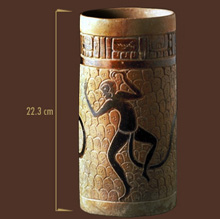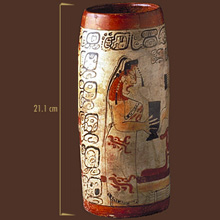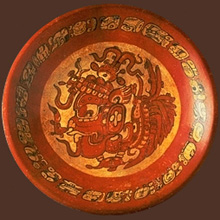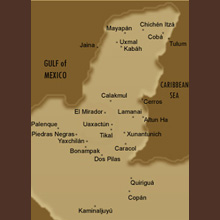let the objects speak
Classic Maya - Ancient Maya Cylinder Vase

Nicknamed the 'Monkey Vase' at the Gardiner Museum, this cylinder is actually a drinking vessel. The incised Spider Monkey, a species native to the Maya Lowlands, is portrayed walking or dancing amidst jungle foliage, or perhaps swinging from a branch or vine. Nature played a pivotal role in Maya life and religion, and this monkey may represent the 'Monkey Man' patron of scribes and artists. Monkeys were believed to have superior intelligence, and are depicted as jealous and scheming in the Highland Maya sacred tale, the Popol Vuh. The vessel's imagery and the presence of hieroglyphs tell us that it was valued by both its maker and its user(s).

Who
This Maya cylinder vase was very probably used, as was the 'Monkey Vase', for the drinking of cacao beverages during feasting and other rituals. The polychrome scene painted on the vessel shows the formality of royal tribute, and the importance of drinking from vessels similar in shape to this one. A woman stands with a cacao drink in hand, which she is about to give to a seated lord. In addition to a dish of tamales and several textile bundles, the painting includes hieroglyphs that are as yet undeciphered.

What
The Maya elite, but almost certainly not the commoners, used hieroglyphs as a means of communication. This plate with a hieroglyphic text around the rim dates to the Classic period, when inscriptions on stone monuments (stelae), and on stone panels, wood, jade, shell, bone, and ceramics told mostly of dynastic rule, calendric calculations, and war. The ancient Maya script is phonetically based. Symbols can represent both whole words and syllables. Decipherment of hieroglyphs is ongoing, as scholars can read a great number of passages but have yet to interpret all glyphs, and new texts appear as archaeologists continue their excavations.

Where
The animal imagery on this vessel is a by-product of life in a region of dense tropical forest. A great many ancient Maya were city-dwellers, but evidence suggests that even so they made efforts to protect areas of the forest that surrounded them. The environment played a major role in shaping the identities and the beliefs of the people who lived in this region so many years ago. Their understanding of the meaning of life and the nature of the universe was, like their language, rooted in the very land, sea, and air, as well as all the creatures, of the Maya world.